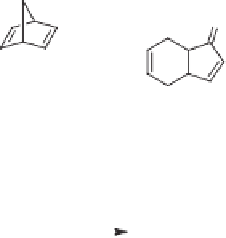Chemistry Reference
In-Depth Information
Tab l e 6 . 7
PKR of
t
-Bu-PNSO-dicobalt complexes with norbornadiene.
X
O
Ph
H
N
Ph
O
S
P
OC
CO
R
Co
Co
OC
CO
Toluene,
Δ
or
H
R
NMO, rt, CH
2
Cl
2
(-)-3
37
S.M.
R
X
Conditions
Product
Yield (%)
ee (%)
37ia
TMS
Bn
NMO,16h
3i
99
97
37ib
TMS
p
-MeO-Bn
70
◦
C, 40 h
3i
99
>
99
37ic
TMS
p
-F-Bn
70
◦
C, 48 h
3i
99
78
37ca
CMe
2
OH
Bn
70
◦
C, 16 h
3c
95
92
37ca
CMe
2
OH
Bn
NMO, 16 h
3c
87
93
37ha
Ph
Bn
rt,4h
3h
99
99
47na
CH
2
OTBDPS
Bn
rt, 5 h
3n
99
92
olefin must also insert into a defined Co-C bond. As mentioned above, due to its higher
symmetry the ligand exchange reaction of PNSO ligands
35a
or
36b
with hexacarbonyl(
-
diphenylacetylene)dicobalt (
39
) produced single complexes
40
or
42
(see Scheme 6.25).
Thermal cyclization of these complexes with norbornadiene provided the corresponding
adduct
41
in low enantiomeric excess. However, somewhat surprisingly, the
N
-oxide-
promoted reactions gave excellent enantioselectivity (up to 96% ee). In this case, ligand
36b
gave a better overall yield but slightly lower selectivity than did
35a
. The modular
nature of these ligands enabled fine tuning to develop a bis-(p-methoxybenzylphosphinyl)
ligand (
36d
), which, in the best case, gave the desired adduct (
41
) in 77% yield and 94%
ee.
Ph
CO
CO
Ph
O
N
H
OC
Ph
CO
O
PS
Co
Co
35a
OC
CO
OC
CO
Co
Co
Ph
OC
CO
Ph
Ph
Thermal (65 °C): 63%, 20% ee
N
-oxide (rt): 23%, 96% ee
H
Ph
Ph
Ph
39
40
(-)-41
i-Bu
O
CO
CO
PMB
O
H
OC
N
CO
p-Tol
PMB
Co
Co
36d
PS
OC
CO
CO
Ph
OC
Co
Co
OC
CO
Ph
Ph
N
-oxide (rt): 77%, 94% ee
H
Ph
Ph
Ph
39
42
(+)-41
Scheme 6.25
Enantioselective PKRs of internal symmetric alkynes.














































































































